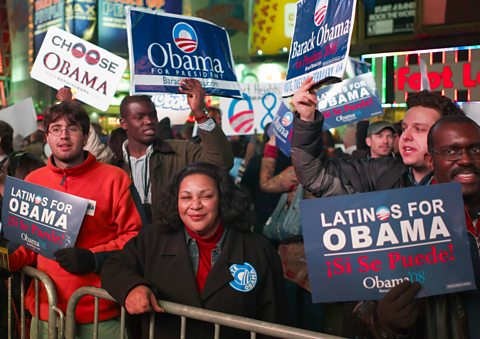Political participation and representation among minority groups

Minority groups are becoming more important in US politics.
In most countries, the poorest people are less likely to participate in politics. In the US, most ethnic minority groups, who are generally poorer than the white majority, are also, historically, less likely to take part in politics, including using their vote. Whites, on the other hand, are more likely to vote, as well as stand as a candidate, join a political party or campaign in local, state, or national elections.
Barack Obama’s successful Presidential election campaigns in 2008 and 2012 were different to previous US elections as they energised black American voters, with many people actively campaigning as well as voting. Hundreds of thousands of volunteers donated money, organised transportation to voting booths, took part in telephone messages, or simply posted the motivational message Yes We Can
, on social media. 65% of black Americans voted in the 2008 Presidential election, the highest figure ever.
In the presidential election of 2016, voting turnout by racial group was similar to the years before Obama with white Americans turning out to vote in the highest percentage numbers. The black American vote in the same year, without Obama to vote for as President this time, fell by seven percentage points from 2012. However black and Hispanic American voters turning out in 2016, plus a higher turnout from white American voters who are more likely to vote Republican, this helped Republican Donald Trump to win.
In the future, with minorities becoming a bigger percentage of the US population and voting in greater numbers, minority groups will become more important in deciding which candidate and parties win elections.
Turnout in US presidential elections 2012, 2016 and 2020 (%) by racial group
| Turnout / Race | 2012 | 2016 | 2020 |
| white | 64.1 | 65.3 | 70.9 |
| black | 66.6 | 59.6 | 62.8 |
| Hispanic | 48.0 | 47.6 | 53.7 |
| Asian | 47.1 | 48.4 | 59.1 |
| Turnout / Race | white |
|---|---|
| 2012 | 64.1 |
| 2016 | 65.3 |
| 2020 | 70.9 |
| Turnout / Race | black |
|---|---|
| 2012 | 66.6 |
| 2016 | 59.6 |
| 2020 | 62.8 |
| Turnout / Race | Hispanic |
|---|---|
| 2012 | 48.0 |
| 2016 | 47.6 |
| 2020 | 53.7 |
| Turnout / Race | Asian |
|---|---|
| 2012 | 47.1 |
| 2016 | 48.4 |
| 2020 | 59.1 |
Representation of minority groups
In the past, minority groups have been under-represented in US politics. This is changing although minority groups are still not represented in politics to their proportion in the population.
Kamala Harris is Joe Biden’s Vice President and former Senator for California. She is the first black and first Asian American Vice President, as well as being the first female Vice President.
President Joe Biden’s Cabinet
President Biden promised to make his Cabinet the most diverse in U.S. history, better representing the make-up of the country. Currently, 55% of US Cabinet members are non-white including Lloyd Austin as Secretary of Defense.
Minority groups in the US Congress
Representation from ethnic minority groups has continued to increase in the US Congress. The 118th Congress (from 2022 midterm election) is the most racially and ethnically diverse in the history of the country with 23% from an ethnic minority background. The majority of these are members of the Democratic Party (83%).
In 2023, of 100 Senators there were:
- 88 white-only senators although white Americans make up only 56% of the population
- 6 Hispanic senators although Hispanic Americans make up only 19.1% of the population
- 2 Asian senators although Asian Americans make up only 6.3% of the population
- 1 American Indian and Alaska Native make up 0.2% of the population.
In 2023, in the House of Representatives (435 members), there were:
- 313 white American-only congressmen/women (72% of all representatives) although white Americans make up only 56% of the population
- 53 black American congressmen/women (12.1%) although Black Americans make up 13.6% of the population
- 46 Hispanic American congressmen/women (10.5%) although Hispanic Americans make up 19.1% of the population
- 14 Asian American congressmen/women (3.2%) although Asian Americans make up 6.3% of the population.
Supreme Court and minority representation
There are nine Supreme Court justices. In 2024, three were from minority groups – Judge Clarence Thomas, Judge Sonia Sotomayor and Judge Ketanji Brown Jackson.
State and local government and minority representation
There are many people from ethnic minority groups who have been elected at state and local level. However, minority groups remain, overall, under-represented at these levels.
Examples of locally minority group elected officials include:
- Governors such as Wes Moore the black American governor of Maryland and only the third black American elected as a governor in US history
- city mayors including Randall Woodfin in Birmingham, Alabama and Karen Bass in Los Angeles, California.